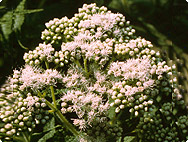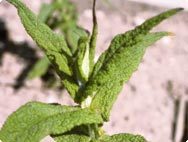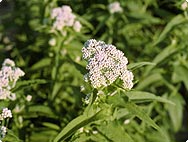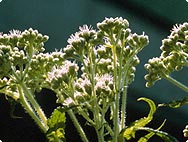A.Vogel search
When the internal search is activated, personal data such as your IP address is transmitted to our search engine Cludo. Data is thus transferred to a third country. Please click here if you want to display the internal search. You can find more information on data protection here: Privacy policy.
A.Vogel plant encyclopaedia
Eupatorium perfoliatum L.
Boneset
History

The Latin name Eupatorium derives from the Greek eupatória, a medicine Pliny attributes to Mithridates VI Eupator, a king of Pontus who lived from 132 to 62 B.C. and who led three wars of conquest against Rome. It is improbable, however, that the king pursued the study of botany. Dioscorides' «Materia Medica» includes a plant with this name, but it has been identified as liverwort (Agrimonia eupatoria). As the name suggests, the liverwort is helpful against liver complaints, and it thus appears eupatoria derives from hepatoria, Latin for «liver». The species name perfoliatum derives from perfoliátus, for «grown through leaves», from per for «through» and foliátus for «leafy».
The North American Indians have known boneset for centuries. They used the leaves and flowering tips of twigs as a sweat-producing agent in remittent and typhous fevers and at the beginning of colds or acute catarrhs. It has been used to treat malaria. Its American name «boneset» indicates its analgesic characteristics when used against the bone pains of dengue fever.
The plant was officinal in the USA from 1820 to 1945 [1].
Botanical characteristics

The boneset is a 1 to 1.5 m high shrub. The erect, bluntly-edged stalk rises from the root stock. The stalk is roughly haired, often red at the base, and branched in the upper part. The undulant, softly-haired leaves are lanceolate-tapering, serrated with notches, and characterized by a marked central vein. They grow 10 to 15 cm long and are opposed. The lower pairs are fused at the base, i.e. they give the impression of being one large leaf «grown through» in the middle by the stalk. This is the origin of the species name, as described above.
The flower heads with white, bell-shaped tubular blossoms stand in cymes at the ends of the stalks. They form small fruits with a bristly pappus, which are distributed by the wind.
The boneset flowers from August to October.
Habitat

Boneset is native to North America, from Canada to Florida and Texas. The only species of the Eupatorium genus native to Europe is E. cannabinum L. The plant prefers moist spots at the margins of bodies of water and in swamps.
Use

The plant is used in folk medicine, phytotherapy, and homeopathy.